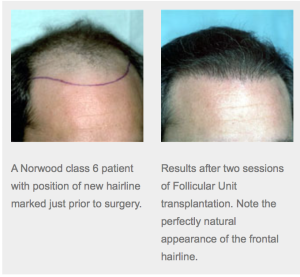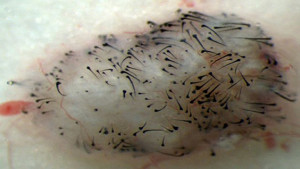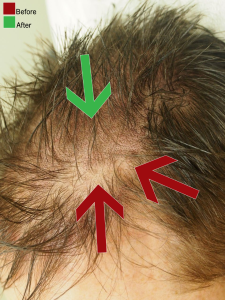The hair in every person’s scalp grows in tiny bundles called follicular units. Although this had been recognized for some time by histologists (doctors who study human tissue), the existence of follicular units was largely ignored by physicians performing hair restoration surgery.
The follicular unit of the adult human scalp consists of 1-4 terminal (full thickness) hair follicles. In areas of the scalp affected by genetic balding, the healthy terminal hairs are gradually replaced by hairs of smaller diameter and length called “miniaturized” hairs.
In addition to the full terminal hairs, the follicular unit contains 1-2 fine vellus hairs, sebaceous (oil) glands, a small muscle, tiny nerves and blood vessels, and a fine band of collagen surrounding the unit (called the perifolliculum). The follicular unit is thus the hair bearing structure of the skin and should be kept intact to insure maximum growth.
The follicular unit is seen on the surface of the scalp as a tiny group of hairs that appear to be growing together. They are best viewed under a microscope where they are seen as well-formed structures in the skin but if you part your hair (say in the middle) and look at with a bright light
A close-up view showing the hair actually emerging in small groups called Follicular Units.
With the hair clipped the natural hair groupings are visualized on the surface of the skin at 30x magnification through an instrument called a densitometer.
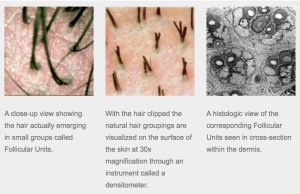
A histologic view of the corresponding Follicular Units seen in cross-section within the dermis.
What is Follicular Unit Transplantation?
Perfectly intact 1-, 2-, 3-, and 4-hair Follicular Units removed from the donor strip using a dissecting stereo-microscope.
Follicular Unit Transplantation is a technique, pioneered by the Physicians at the New Hair Institute, in which hair is transplanted from the permanent zone in the back of the scalp into areas affected by genetic balding, using only the naturally occurring, individual follicular units.
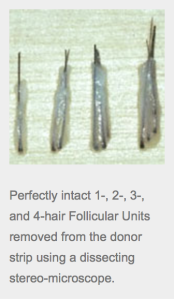
In order to remove Follicular Units from the back of the scalp without damaging them, the donor tissue is removed in one piece. This technique, called Single Strip Harvesting, is an essential component of follicular unit transplantation as it not only preserves the follicular units, but it prevents damage (transection) to the individual hair follicles. It differs dramatically from the mini-micrografting technique of using a multi-bladed knife that breaks up follicular units and causes unacceptable levels of transection of hair follicles. Another harvesting technique, Follicular Unit Extraction, allows the surgeon to remove individual follicular units without a linear donor incision.
Another essential component of Follicular Unit Transplantation is Stereo-Microscopic Dissection.
In this technique all of the follicular units are removed from the donor tissue under microscopic control to avoid damage. Complete stereo-microscopic dissection has been shown to produce an increased yield of both the absolute number of follicular units, as well as the total amount of hair, (upwards of 25%). (This procedure differs from mini-micrografting in which the grafts are cut with minimal or no magnification.)
A major advantage of follicular unit transplantation, (besides preserving follicular units and maximizing growth) is the ability to use small recipient sites. Grafts comprised of individual follicular units are small because Follicular Units are themselves small, but also because the surrounding non-hair bearing tissue is removed under the microscope and doesn’t need to be transplanted. Follicular unit grafts can be inserted into tiny needle-sized sites in the recipient area, which heal in just a few days without leaving any marks.
When performed by a skilled surgical team, Follicular Unit Transplantation can provide totally natural looking hair transplants that make the full use of the patient’s donor supply to give the best possible cosmetic results in the fewest possible sessions.
A Norwood class 6 patient with position of new hairline marked just prior to surgery.
Results after two sessions of Follicular Unit transplantation. Note the perfectly natural appearance of the frontal hairline.
